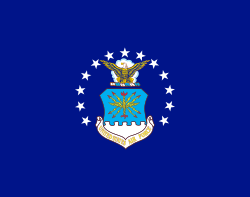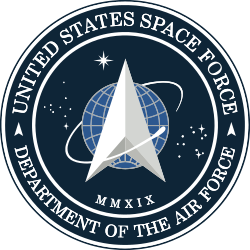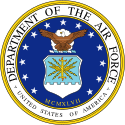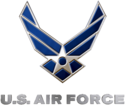United States Air Force
| United States Air Force | |
|---|---|
Luftvåbnets segl | |
| Grundlagt | 18. september 1947 |
| Land | |
| Rolle | Luftvåben |
| Overordnet myndighed | Luftvåbenministeriet |
| Størrelse | 332.854 militært ansatte 185.522 civilt ansatte 71.400 reservister +5600 Fly |
| Hovedkvarter | Pentagon |
| Kaldenavn(e) | USAF |
| Farver | Ultramarin og guld |
| March | The U.S. Air Force |
| Hjemmeside | http://www.af.mil/ |
| Insignier | |
| Flag | |
| National kokarde | |
| Logo | |
| Fly fløjet | |
| Jagerbomber | A-10 Thunderbolt II Lockheed AC-130 |
| Bombefly | B-52 Stratofortress B-1 Lancer B-2 Spirit MQ-9 Reaper |
| Elektronisk krigsførelse | E-3 Sentry Lockheed EC-130 Northrop Grumman E-8 Joint STARS |
| Jager | F-15 Eagle C/E F-16 Fighting Falcon F-22 Raptor |
| Multirollehelikopter | Sikorsky HH-60 Pave Hawk Bell UH-1N Twin Huey |
| Rekognoscering | U-2 RC-135 Rivet Joint RQ-4 Global Hawk RQ-170 Sentinel |
| Træning | T-6 Texan II T-38 Talon T-1 Jayhawk |
| Transport | C-130 Hercules C-5 Galaxy C-17 Globemaster III VC-25 C-32 C-40 Clipper V-22 Osprey |


USA's luftvåben,[1] United States Air Force (USAF), er et af USA's seks værn.
Under Den amerikanske borgerkrig anvendtes brintballoner til artilleriobservation og i 1909 indkøbtes et fly fremstillet af brødrene Wright. I 1912 blev en aeronautisk sektion af "U.S. Army Signal Corps" oprettet. I 1917, da USA gik ind i 1. verdenskrig, blev "U.S. Army Air Service" formet som en del af "American Expeditionary Force" (AEF). I 1926 blev "Air Service" reorganiseret som en gren af hæren og blev til "U.S. Army Air Corps" (USAAC). I 1941, blev "Army Air Corps" til "U.S. Army Air Forces" (USAAF).
I 1947 blev "Army Air Forces" til et selvstændigt værn under navnet: "United States Air Force". U.S. Army beholdt dog helikoptere og små propelfly i det nyoprettede "Army Aviation". I 1947 oprettedes også Air National Guard, et lufthjemmeværn med jetjagere.
USAF består pr. 2004 af 352.000 aktive folk og 9.000+ fly.
US Air Force har Department of the Air Force (luftvåbenministeriet) som politisk paraply.
Tal for USAAF under 2. Verdenskrig
- 1941-45 leveredes i alt 291.191 flyvemaskiner og 781.818 flymotorer
- mandskab i 1940: 7.707 mand, mandskab i 1945: 1.224.006 mand
- flyvemaskiner til rådighed januar 1940: 2.588 stk
- flyvemaskiner til rådighed juli 1944: 79.908 stk, heraf 12.467 tunge bombefly, 15.793 jagerfly, 9.908 transportfly, 27.568 skole- og træningsfly
- samlet nedkast af bomber: 2.057.244 tons
- samlet flyvetid: 107.836 timer[2]
Historie, kort
- 1947-91 Opretholdt et beredskab af kernevåbenbestykkede bombefly og senere ICBM under Den kolde krig
- 1948-49 Operation Vittles, luftbroen til Vestberlin.
- 1950-53 Støttede FN’s landstyrker i Koreakrigen.
- 1964-73 Vietnamkrigen.
- 1973 Operation Nickel Grass, luftbro med våben til Israel i Oktoberkrigen.
- 1979 Operation Eagle Claw, mislykket gidselredningsaktion i Iran.
- 1986 Operation El Dorado Canyon, bombning af Libyen.
- 1990-91 Operation Desert Shield, beskyttelse af Saudi-Arabien mod Irak.
- 1991 Operation Desert Storm mod Irak.
- 1991-96 Operation Provide Comfort, flyveforbudszone nord for 36°N i Irak.
- 1991-2003 Operation Southern Watch, flyveforbudszone syd for 33°N i Irak.
- 1993-95 Operation Deny Flight, flyveforbudszone over Bosnien-Hercegovina.
- 1995 Operation Deliberate Force, bombninger i Bosnien-Hercegovina.
- 1996 Operation Desert Strike, bombninger af Irak.
- 1997-2003 Operation Northern Watch, flyveforbudszone nord for 36°N i Irak.
- 1998 Operation Desert Fox, bombninger af Irak.
- 1999 Operation Allied Force, bombninger i Jugoslavien, som led i Kosovokrigen.
- 2001-21 Operation Enduring Freedom, bombninger i Afghanistan.
- 2003-04 Operation Iraqi Freedom, invasion af Irak.
- 2011 Operation Odyssey Dawn, flyveforbudszone over Libyen.
- 2014 Operation Inherent Resolve, bombninger af Islamisk Stat i Irak og Syrien.
Referencer
Eksterne henvisninger
| ||||||||
|
Medier brugt på denne side
Seal of the United States Space Force.
Seal of United States Department of the Air Force - military department for the United States Air Force and the United States Space Force
Image taken from united-states-flag.com. This is a faithful representation of an original U.S. government work. As such, it attracts no new copyright. However, the USMC flag is protected by U.S. Trademark Registration Nos. 4852947 and 4193304, and may not be used commercially without a trademark license from the USMC's Trademark Licensing Office. Originally uploaded to en.wikipedia by Mbr7975; description page is (was) here: Marine corps flag.gif
Bell, Dana (1995) Air Force Colors Volume 1 1926-1942, Carrollton: Squadron Signal Publications ISBN: 0-89747-316-7.
according to Section 40.1.1.2 Color of MIL-STD-2161A (AS), the colors of this insignia are established as FED-STD-595 red 11136 white 17925 blue 15044. The visualization of the colors comes from http://www.colorserver.net/showcolor.asp?fs=11136+17925+)
Elliot, John M. (1989) The Official Monogram US Navy & Marine Corps Aircraft Color Guide Vol 2 1940-1949, Sturbridge, MA: Monogram Aviation Publications ISBN: 0-914144-32-4.The Service Color of the U.S. Coast Guard. This is not the same as the law enforcement ensign, which features vertical red stripes defaced with the anchor symbol of the USCG.
Roundel of the United States Air Force and aircraft operated by the United States Navy and United States Marine Corps
Seal of the United States Department of Defense from 2001 to 2022.
Roundel used by the United States armed forces from 19 August 1919 to 6 May 1942 until red dot removed to avoid confusion with Japanese insignia. Superseded very similar roundel whose colors and proportions differed slightly - the original version having the colors from the US flag, and a center dot 1/3 of the outer radius. This version has a center dot constrained by the inner vertices of the star, a size that does not translate into an even fraction.
The Flag of the United States Navy, as defined in Executive Order 10812 of April 24, 1959. The design is described there as:
The flag for the United States Navy is 4 feet 4 inches hoist by 5 feet 6 inches fly, of dark blue material, with yellow fringe, 2½ inches wide. In the center of the flag is a device 3 feet and 1 inch overall consisting of the inner pictorial portion of the seal of the Department of the Navy (with the exception that a continuation of the sea has been substituted for the land area), in its proper colors within a circular yellow rope edging, all 2 feet 6 inches in diameter above a yellow scroll inscribed "UNITED STATES NAVY" in dark blue letters.
The U.S. Navy flag is used for display purposes at ceremonies, parades, and other public functions where the U.S. Navy has an official presence, usually being carried by an honor guard on ceremonial occasions. It is not used for outdoor, fixed (permanent) purposes, and is not flown on Navy ships. Versions without fringe and different dimensions seem to be common, though it appears they are not technically the official U.S. Navy flag, as the executive order has not been amended.
Prior to 1959, the Navy Infantry Battalion flag was used to represent the U.S. Navy.
For more information, see the Navy's flag history page, SeaFlags, Flags of the World, U.S. Navy document NTP 13(B) [1], section 1710, and Navy regulation OPNAVINST 10520.1 (which replaced a similar SECNAVINST 10520.2D regulation from 1974).Det er let at give dette billede en kant
United States Air Force logo, blue and silver. Cropped out for transparency using Photoshop.












